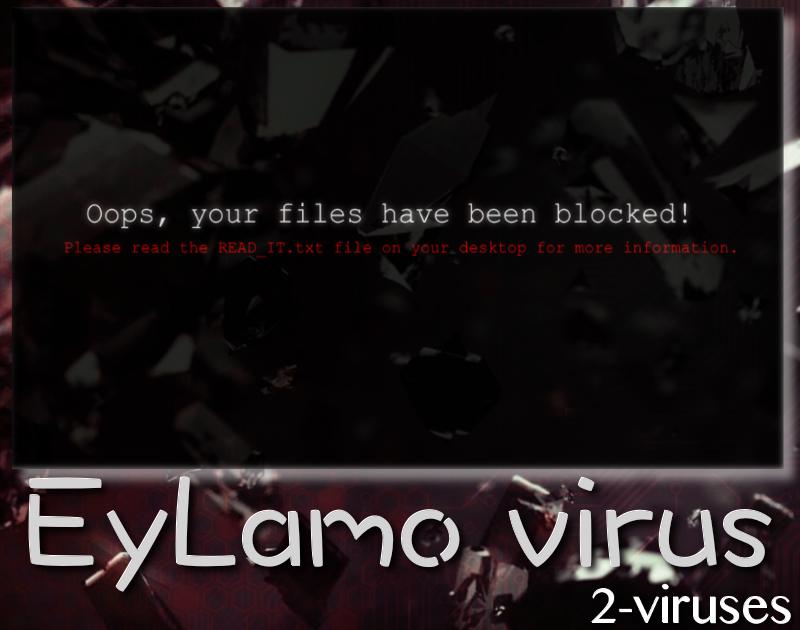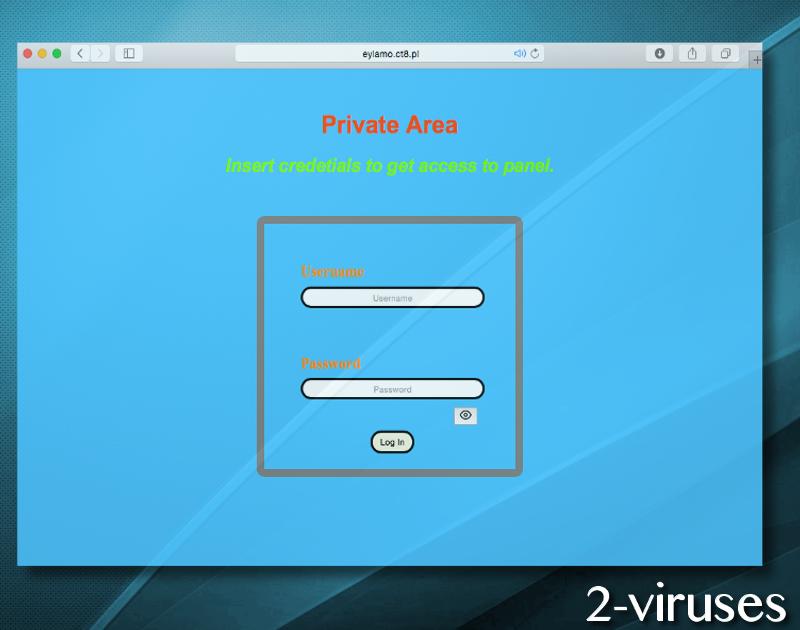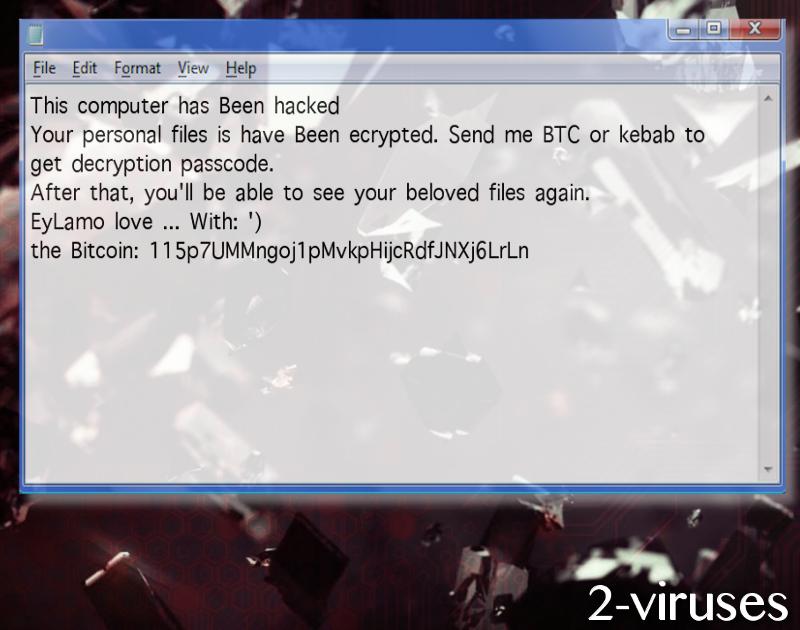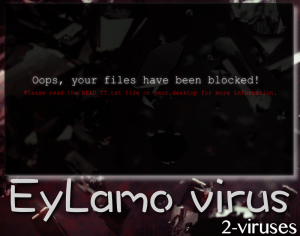EyLamo ransomware virus was quickly red-flagged by security researchers and the prognosis is that it aspires to carry out file-encryption. A popular cryptography algorithm is taken as the tool to encode files: an AES cipher. The newly-detected virus is based on a classic Hidden Tear open-source project which is dominating in the ransomware industry. The virus implants a READ_IT.txt on the users’ desktop and also changes the individual background image. The message in the new desktop picture is regular for crypto-viruses and it encourages victims to read the .txt file for additional information.

Significant evidence has been found to support the theory of EyLamo, originating from Germany. The initiated investigation showed some surprising results. Firstly, crypto-virus sends a DNS requests to a Eylamo.ct8.pl website, containing an odd-looking table to log in. The domain leads to a private area which requires certain credentials to get access to the full panel. It is registered in Germany, IP address: 136.243.156.120.

Speaking of the ransom note, it is not the first time that crooks are trying to be humorous and asking for a kebab. Surprisingly, the exact amount of demanded bitcoins is not indicated, only the bitcoin wallet that the transaction should be send to. Maybe hackers expect people to determine their own fees?

Additionally, the creators continue on mocking users by adding a postscript of “with love”. Despite attempting to be charming or funny, this crypto-virus should successfully carry out file-encryption process. The influenced digital data will feature new extensions: .lamo. This will help victims determine which executables have been corrupted. While this infection probably won’t be one of the widespread nightmares like WannaCry, it is possible that some users are going to have their data broken by this specific sample.
Staying save from ransomware infections, their removal and possible decryption techniques
If getting compromised by ransomware does not sound exciting, we can enumerate a number of possible techniques that will help you avoid any damages. One of the best decisions would be to store files in backup storages or upload additional copies in USB flash drives. If you create an alternative location to get back your files from, then losing the original executables from your hard drive will be an easily reversible action.
However, let’s say the infection has already emerged, your desktop background is changed and the extension has been appended. In this case, you should give security researchers some time to generate an original tool for file-decryption. If you wish to try other methods, then remove the crypto-virus. Elimination can be easily implemented with tools like Spyhunter or Hitman. They will continue on securing your device from infections and won’t allow hackers to implant their malicious payloads.
Then, we invite you to read more about the possible techniques to recover files. Observe the way Shadow Volume Copies can be restored or which universal tools could be helpful. Also, instructions for a manual removal are also explained.
The last part in this article should provide details about the distribution of this infection. Over time, a number of possible methods have been established. Hackers have become fond of one of the easiest methods which is the delivery of payloads in misleading emails. Many users might have become compromised when some spam reached their account. However, this does not mean an immediate infection: users have to download the executable they received.
Therefore, we insist that users would evaluate the reliability of messages they receive. If a letter looks suspicious and originates from unrecognized sources, please be cautious. By being able to separate legitimate emails from rogue ones, you will have a better chance of staying free from malware.
Eylamo Virus quicklinks
- Staying save from ransomware infections, their removal and possible decryption techniques
- Automatic Malware removal tools
- How to recover EyLamo virus encrypted files and remove the virus
- Step 1. Restore system into last known good state using system restore
- 1. Reboot your computer to Safe Mode with Command Prompt:
- 2.Restore System files and settings.
- Step 4. Use Data Recovery programs to recover EyLamo virus encrypted files

Automatic Malware removal tools
(Win)
Note: Spyhunter trial provides detection of parasites and assists in their removal for free. limited trial available, Terms of use, Privacy Policy, Uninstall Instructions,
(Mac)
Note: Combo Cleaner trial provides detection of parasites and assists in their removal for free. limited trial available, Terms of use, Privacy Policy, Uninstall Instructions, Refund Policy ,
How to recover EyLamo virus encrypted files and remove the virus
Step 1. Restore system into last known good state using system restore
1. Reboot your computer to Safe Mode with Command Prompt:
for Windows 7 / Vista/ XP
- Start → Shutdown → Restart → OK.
- Press F8 key repeatedly until Advanced Boot Options window appears.
- Choose Safe Mode with Command Prompt.

for Windows 8 / 10
- Press Power at Windows login screen. Then press and hold Shift key and click Restart.

- Choose Troubleshoot → Advanced Options → Startup Settings and click Restart.
- When it loads, select Enable Safe Mode with Command Prompt from the list of Startup Settings.

2.Restore System files and settings.
- When Command Prompt mode loads, enter cd restore and press Enter.
- Then enter rstrui.exe and press Enter again.

- Click “Next” in the windows that appeared.

- Select one of the Restore Points that are available before EyLamo virus has infiltrated to your system and then click “Next”.

- To start System restore click “Yes”.

Step 2. Complete removal of EyLamo virus
After restoring your system, it is recommended to scan your computer with an anti-malware program, like Spyhunter and remove all malicious files related to EyLamo virus. You can check other tools here.Step 3. Restore EyLamo virus affected files using Shadow Volume Copies
If you do not use System Restore option on your operating system, there is a chance to use shadow copy snapshots. They store copies of your files that point of time when the system restore snapshot was created. Usually EyLamo virus tries to delete all possible Shadow Volume Copies, so this methods may not work on all computers. However, it may fail to do so. Shadow Volume Copies are only available with Windows XP Service Pack 2, Windows Vista, Windows 7, and Windows 8. There are two ways to retrieve your files via Shadow Volume Copy. You can do it using native Windows Previous Versions or via Shadow Explorer. a) Native Windows Previous Versions Right-click on an encrypted file and select Properties → Previous versions tab. Now you will see all available copies of that particular file and the time when it was stored in a Shadow Volume Copy. Choose the version of the file you want to retrieve and click Copy if you want to save it to some directory of your own, or Restore if you want to replace existing, encrypted file. If you want to see the content of file first, just click Open.
b) Shadow Explorer It is a program that can be found online for free. You can download either a full or a portable version of Shadow Explorer. Open the program. On the left top corner select the drive where the file you are looking for is a stored. You will see all folders on that drive. To retrieve a whole folder, right-click on it and select “Export”. Then choose where you want it to be stored.

Step 4. Use Data Recovery programs to recover EyLamo virus encrypted files
There are several data recovery programs that might recover encrypted files as well. This does not work in all cases but you can try this:- We suggest using another PC and connect the infected hard drive as slave. It is still possible to do this on infected PC though.
- Download a data recovery program.
- Install and scan for recently deleted files.








